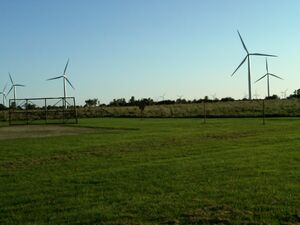
"If you stop learning, you stop growing." - Chris Hadfield
About Me
My name is Jerome James. I am currently a Masters student at Queens University in Kingston Ontario Canada. My research interest is in renewable energy applications and methods of making societies truly sustainable. My current avenue to explore this area is through the Applied Sustainability (MME 836) course offered by Dr. J.M. Pearce. Before arriving at Queen's, I completed at Mechanical Engineering degree at the University of Western Ontario.
MME 836 Project: Renewable Energy For Canada's North

My project investigates the viability of making northern communities more sustainable by replacing fossil fuel power plants with a mix of renewable energy sources.
Websites of Interest
Canadian Wind Energy Atlas - A great resource for mapping various wind information across Canada.
Qulliq Energy Corp. - This is the power company for the territory of Nunavut. Contains good information dealing with production and electricity pricing.
Solar Radiation Atlas of Canada - Contains great map information of annual solar radiation in Canada.
Wind Energy in Cold Climates - Information on Wind Energy in Cold Climates
Canadian Wind Energy Association - Information on wind energy in Canada
Literature Review
Search Engine: Google Scholar
Search Terms: Renewable Energy in the Arctic
energy in harsh climatesenergy in harsh climates
[1] Christopher Brown, Antoine Guichard, David Lyons, “WIND-ENERGY IN POLAR REGIONS: CASEY STATION ANTARCTICA” Institute of Antarctic and Southern Ocean Studies, 1996.
Abstract:
The use of alternative energy for electrical and thermal power generation at the Australian Antarctic stations is currently being investigated. The conditions experienced at the stations, with recorded wind gusts of 81 m/s and minimum temperatures of -41o C, have imposed harsh restrictions on the usage of wind in all but small scale applications. With the latest design of wind turbines, however, the use of larger units is now becoming feasible. Analysis of meteorological data indicates that winds ideal for power generation exist at some of the stations. To test for reliability, an Aérowatt UM-70X wind-turbine rated at 10 kW has been installed at Casey Station Antarctica. Casey is one of three stations operated by the Australian Antarctic Division on the Antarctic continent (with a fourth station operated in the sub-Antarctic on Macquarie Island). All stations experience high winds and cold temperatures resulting in high consumption levels of diesel fuel for power generation. Results and problems associated with the operation of this unit over a 15 month period, in which 11.5 MWh of power has been produced, are presented after an analysis indicating the potential for exploitation of wind (in combination with solar) resources at each of the Australian Antarctic stations.
[2] L. Dignard-Bailey, S. Martel and M.M.D. Ross, “PHOTOVOLTAICS FOR THE NORTH: A CANADIAN PROGRAM” CANMET-Energy Diversification Research Laboratory, NRCan, 1998.
Abstract:
Large seasonal variations in solar radiation and other adverse climatic factors have made the implementation of PV technologies challenging in Canada, especially in the North; however, through the development of new technologies adapted to cold climates and the development of expertise in this field, this challenge is being met. This paper reports on the experience and results of PV for the North, a Canadian program that started in 1993 in response to a need for PV systems better adapted to harsh arctic conditions and information on the technology. This five year program was initiated by the CANMET Energy Diversification Research Laboratory (CERDL), the Aurora Research Institute and the Nunavut Research Institute to address the various issues of importance in the particular context of Canada’s north. The achievements of this program have been reached because of its complete range of activities: from market assessment to product development, to demonstration systems and information dissemination.
[3] Thomas Ackermann ∗Lennart So¨der, “An overview of wind energy-status 2002” Renewable and Sustainable Energy Reviews, Vol.6 Issue(1-2), p.67-127, 2002.
Abstract:
The paper provides an overview of the historical development of wind energy technology and discusses the current world-wide status of grid-connected as well as stand-alone wind power generation. During the last decade of the twentieth century, grid-connected world-wide wind capacity has doubled approximately every three years. Due to the fast market development, wind turbine technology has experienced an important evolution over time. An overview of the different design approaches is given and issues like power grid integration, economics, environmental impact and special system applications, such as offshore wind energy, are discussed. Due to the complexity of the wind energy technology, however, this paper mainly aims at presenting a brief overview of the relevant wind turbine and wind project issues. Therefore, detailed information to further readings and related organizations is provided. This paper is an updated version of the article [`]Wind Energy Technology and Current Status: A Review', published in Renewable and Sustainable Energy Reviews, 4/2000, pp. 315-374. This update was requested by Elsevier due to the large interest in wind power.
[4] Genevieve St. Denis a, Paul Parker, “Community energy planning in Canada: The role of renewable energy” Renewable and Sustainable Energy Reviews, Vol.13 Issue(8), p.2088-2095, 2009.
Abstract:
An emerging trend in Canada is the creation of community energy plans, where decisions that used to be left to regional level energy agencies or private individuals are now being considered at the community level. A desire to reduce greenhouse gas emissions and to become more energy self-sufficient is driving this change. Theoretically, local level management is desirable because it achieves these goals through improvements in the three areas of energy efficiency, energy conservation and switching to renewable energy sources. The analysis of 10 of the first community energy plans in Canadian communities, ranging in population size from 500 to one million, finds that communities are choosing policies and programs centered on increasing energy efficiency and conservation while renewable energy receives much less attention. Municipal operations were called upon to set higher targets than the general community. Communities that recognized the substantial potential of renewable energy often focused on technologies that the municipal sector could implement, such as bio-fuels for their transportation fleet. Wind, passive solar design, solar photovoltaics and solar thermal options were only recommended in a few cases. Overall, only one of the five larger communities (Calgary) recommended implementing multiple renewable energy technologies while three of the five smaller communities proposed multiple renewable energy sources. The implication is that smaller and more remote communities may be the most willing to lead in the planned introduction of renewable energy systems.
[5] Patrick Moriarty, Damon Honnery, “Intermittent renewable energy: The only future source of hydrogen?” International Journal of Hydrogen Energy, Vol.32 Issue(12), p.1616-1624, 2007.
Abstract:
In this paper we assess the feasibility of various future energy production pathways for hydrogen. We argue that neither nuclear energy, nor coal gasification with carbon collection and storage can provide sufficient climate-neutral energy to be probable routes to a hydrogen future. Their contributions are likely to be too little and too late to be of much help. Hydroelectricity, geothermal and biomass energy can all provide base-load power, but even combined have limited potential, and are not always climate-neutral in operation. On the other hand, the high-potential renewable energy (RE) sources, particularly wind and direct solar energy, are intermittent. Further, wind resources are poorly matched to the existing distribution of world population. Wind power’s high potential compared with present electricity demand, high return on energy invested, intermittency, and mismatch with load centers all favour hydrogen conversion and transmission to load centers.
[6] William Isherwood, “Remote power systems with advanced storage technologies for Alaskan villages” Energy, Vol.25 Issue(10), p.1005-1020, 2000.
Abstract:
This paper presents an analytical optimization of a remote power system for a hypothetical Alaskan village. The analysis considers the potential of generating renewable energy (e.g., wind and solar), along with the possibility of using energy storage to take full advantage of the intermittent renewable sources available to these villages. Storage in the form of either compressed hydrogen or zinc pellets can then provide electricity from hydrogen or zinc–air fuel cells whenever wind or sunlight are low. The renewable system is added on to the existing generation system, which is based on diesel engines. Results indicate that significant reductions in fossil fuel consumption in these remote communities are cost effective using renewable energy combined with advanced energy storage devices. A hybrid energy system for the hypothetical village can reduce consumption of diesel fuel by about 50% with annual cost savings of about 30% by adding wind turbines to the existing diesel generators. Adding energy storage devices can further reduce fuel use, and depending on the economic conditions potentially reduce life-cycle costs. With optimized energy storage, use of the diesel gensets can be reduced to almost zero, with the existing equipment only maintained for added reliability. However, about one quarter of the original fuel is still used for heating purposes. Published by Elsevier Science Ltd.
[7] Timothy M. Weis, Adrian Ilinca, “[http://www.sciencedirect.com/science/article/B6V4S-4R05J2P-2/2/370e04721cd0d66e2bbb57bf42e18236 The utility of energy storage to improve the economics of wind–diesel
power plants in Canada]” Renewable Energy, Vol.33 Issue(7), p.1544-1557, 2008.
Abstract:
Wind energy systems have been considered for Canada's remote communities in order to reduce their costs and dependence on diesel fuel to generate electricity. Given the high capital costs, low-penetration wind-diesel systems have been typically found not to be economic. High-penetration wind-diesel systems have the benefit of increased economies of scale, and displacing significant amounts of diesel fuel, but have the disadvantage of not being able to capture all of the electricity that is generated when the wind turbines operate at rated capacity.
Two representative models of typical remote Canadian communities were created using HOMER, an NREL micro-power simulator to model how a generic energy storage system could help improve the economics of a high-penetration wind-diesel system. Key variables that affect the optimum system are average annual wind speed, cost of diesel fuel, installed cost of storage and a storage systems overall efficiency. At an avoided cost of diesel fuel of 0.30 $Cdn/kWh and current installed costs, wind generators are suitable in remote Canadian communities only when an average annual wind speed of at least 6.0 m/s is present. Wind energy storage systems become viable to consider when average annual wind speeds approach 7.0 m/s, if the installed cost of the storage system is less than 1000 $Cdn/kW and it is capable of achieving at least a 75% overall energy conversion efficiency. In such cases, energy storage system can enable an additional 50% of electricity from wind turbines to be delivered.
[8] Christine Apold and Jordan Morelli, “[Design and modelling of a zero-emission power system for Coral Harbour, Nunavut]” Canadian Undergraduate Physics Journal, Vol.3 Isssue (1), 2004.
Abstract:
Providing remote communities with reliable, inexpensive power has long been a challenge. Coral Harbour, Nunavut, with a population of 721, was selected as a test site for analyzing the feasibility of implementing a zero-emission power system. The current distribution grid has 1310 kW of installed capacity and experiences a peak demand of approximately 600 kW. In the proposed design, all energy requirements will be met by wind turbines and a two-phase storage system consisting of deep-discharge batteries and hydrogen storage. The system was modelled in MATLAB and the components were optimized for the least expensive arrangement. As renewable technologies are still developing, three cost scenarios were simulated for 5, 10, and 15 years hence. The per-kWh cost for these technologies post-commercialization is estimated at 34.9¢/kWh, which is very competitive with the current diesel price of 53.5¢/kWh. Therefore, further research into this opportunity is recommended.